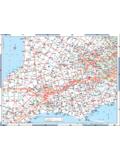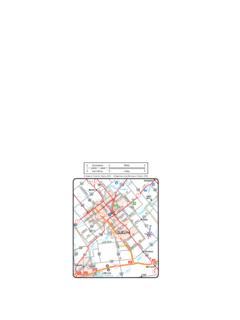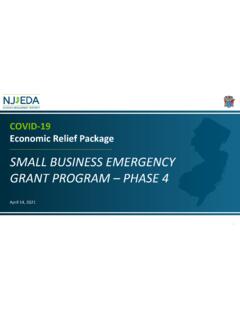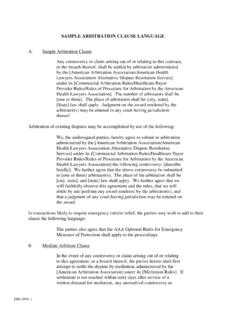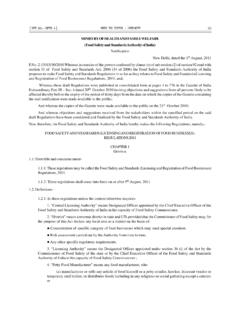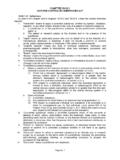Transcription of Commercial Truck Driver Training Standard (Class A)
1 December 2020 Commercial Truck Driver Training Standard (Class A) Ministry of TransportationPage 1 Commercial Truck Driver Training Standard (Class A)AMENDMENT RECORDA mendment InformationName of ManualPrefixAmendment NumberDate PublishedCommercial Truck Driver Training Standard (Class A)CTDTSV ersion 1 July 2016 Commercial Truck Driver Training Standard (Class A) FinalCTDTSV ersion 2016 Commercial Truck Driver Training Standard (Class A) CTDTSV ersion 2 January 2020 Commercial Truck Driver Training Standard (Class A) CTDTSV ersion 2020 Page 2 AMENDMENT RECORD Commercial Truck Driver Training Standard (Class A)Page 3 Commercial Truck Driver Training Standard (Class A)TABLE OF CONTENTSAMENDMENT RECORDPage 1 TABLE OF CONTENTSPage 3 INTRODUCTIONPage 5 PrefacePage 5 Three Paths for Receiving Approved TrainingPage 5 How to ApplyPage 5 Registering Student CompletionPage 5 PART A COURSE DELIVERY STANDARDPage 7 Approach to Curriculum DevelopmentPage 7 Course StructurePage 8 Facility RequirementsPage 9 Three Learning EnvironmentsPage 9 Course HoursPage 10 Student to Instructor RatioPage 10 Instructor QualificationPage 11 Vehicle ConfigurationPage 11 PART B CURRICULUM STANDARDPage 13 Development FormatPage 13 Instructional Methods Page 13 Support Materials Page 13 Transcripts Page 14 Copyright StatementPage 14 Page 4 TABLE OF CONTENTS Commercial Truck Driver Training Standard (Class A)PART C CURRICULUM FRAMEWORKPage 15 LEARNING INDICATORS AND PERFORMANCE MEASUREMENTS1.
2 EMPLOYMENT IN THE Commercial VEHICLE INDUSTRYPage 212. VEHICLE COMPONENTS & SYSTEMSPage 273. BASIC DRIVING TECHNIQUESPage 294. PROFESSIONAL DRIVING HABITSPage 395. TRACTOR TRAILER OFF ROAD TASKS & MANOEUVRESPage 436. DOCUMENTS, PAPERWORK & REGULATORY REQUIREMENTSPage 517. VEHICLE INSPECTION ACTIVITIESPage 558. HOURS OF SERVICE COMPLIANCEPage 679. CARGO SECUREMENT & LOSS PREVENTIONPage 7110. HANDLING EMERGENCIESPage 75 PART D APPENDIXPage 77 Glossary of Terms Page 77 Acknowledgment Page 81 Contact InformationPage 81 Page 5 Commercial Truck Driver Training Standard (Class A)INTRODUCTIONP refaceThe Ontario Ministry of Transportation (MTO) is committed to enhancing road safety for new Commercial drivers and other road instruction provides a foundation for safe and responsible professional driving and serves as a valuable opportunity to help develop positive driving attitudes and behaviours in new Commercial Commercial Truck Driver Training Standard (Class A) includes minimum requirements that curriculum developers are required to meet or exceed.
3 Use of the Standard in the development of your curriculum will help to ensure that you, as a Course Provider, deliver accurate and consistent information within the Commercial Truck driving goal of the Standard is to set high and consistent entry level Training for all Commercial Truck Driver courses delivered in Commercial Truck Driver Training Standard (Class A) is being introduced to ensure that all applicants of a Class A Driver s licence are being trained to the minimum, common core entry level Standard across the trucking industry and Commercial Driver Training delivered in the Standard will be released July of 2016 with the implementation date of July 1, 2017. This provides the trucking and Training industries a transition period to meet the requirements under the Commercial Truck Driver Training Standard (Class A) including any revisions to their Training Paths for Receiving Approved TrainingUnder the Standard , there are three paths for providing or receiving Driver Training ; the MTO s Driver Certification Program (DCP), the Ministry of Colleges and Universities (MCU) Private Career Colleges (PCC), or the Ontario College of Applied Arts and Technology (OCAAT).
4 How to ApplyDepending on the nature of the course provider s business, providers will have to apply through MTO or Student CompletionAdministrators of approved course providers will be given access to the MTO s database. Successful course completion must be entered on to the system which will confirm that the student completed the mandatory course and will be eligible to complete the Class A road 6 INTRODUCTION Commercial Truck Driver Training Standard (Class A)Page 7 Commercial Truck Driver Training Standard (Class A)PART A COURSE DELIVERY STANDARDA pproach to Curriculum DevelopmentContinually reinforce the following overarching themes:a) safety and risk,b) benefits of social responsibility,c) benefits of environmental responsibility,d) self awareness of personal values, attitudes and personal insight and appreciation for critical self awareness and continual improvement when evaluating abilities, limitations and to a learner centred approach by.
5 A) encouraging the active participation of each learner,b) supporting and facilitating self directed learning where applicable,c) allowing for integration of personal experiences,d) ensuring knowledge and skills are acquired at a pace appropriate to individual learners,e) giving learners autonomy by providing them with the opportunity to reach their own conclusions and guiding them towards achieving the intended learning outcomes,f) encouraging learners to learn from their mistakes in a safe learning environment,g) emphasizing the importance of lifelong the understanding and practice of cooperative reinforce how formal rules of the road, common safe practices of road users and informed decision making contribute to safe and responsible the most recent and contemporary views of traffic safety, education and Training , social change and acknowledge emerging a variety of driving environments, road conditions and 8 PART A - COURSE DELIVERY Standard Commercial Truck Driver Training Standard (Class A)Course StructureAddress all competencies as they are outlined in the Curriculum reinforce driving theory, skills practice and promotion of positive driving attitudes in all educational settings using a variety of instructional strategies and methods, including.
6 A) Direct Instruction,b) Indirect Instruction,c) Interactive Instruction,d) Experiential Instruction,e) Independent topics and materials in a logical sequence allowing for the development of knowledge and skills throughout the different stages of learning to ensure any prerequisites are designed to allow for easy updating, removal, and insertion of content as adaptable to meet individual learner learning needs ( , age, ability, culture) and regional 8 hours/day of instruction may be, for example: Maximum use of 8 hours 1 hour of in cab following 7 hours of classroom 4 hours in class, 2 hours in yard, 2 hours in cab 1 hour in class, 2 hours in yard, 5 hours in cabAdhere to the following classroom instruction requirements:a) Approved instructors and learners must be present in the classroom during classroom instruction,b) Maximum 8 hours/day of classroom instruction (excluding lunch or dinner),c) Indirect instruction, interactive instruction and experiential learning methods shall comprise a minimum of 50% of total classroom instruction hours,PART A - COURSE DELIVERY STANDARDPage 9 Commercial Truck Driver Training Standard (Class A)d) Direct instruction methods (lecture) shall comprise not morethan a maximum of 50% of total classroom instruction to the following non classroom (in yard and in cab) instruction requirements:a) Maximum 2 hours/session instruction at one time, followed bya )Maximum 6 hours/day, in cab instruction.
7 A one time in cabextension up to 8 hours will be permitted to be used towardexpressway Training , provided the student has achieved a pointof skills/knowledge capability and stamina to complete 8 hoursthat includes expressway RequirementsThe facility where the Training is to take place must meet all Occupational Health and Safety Act (OHSA) requirements, local municipal by laws and adhere to the requirements by each host ministry. Space ratio to student Tables Washrooms Lighting Heat/cooling Accessibility Contact MTO or MCU for further details on Learning EnvironmentsThere are three learning environments identified for the delivery of the Commercial Truck Driver Training (A). In class refers to the classroom environment In yard (around the vehicle) refers to activities that occuraround the vehicle ( vehicle inspection). In cab (Behind the Wheel) refers to the student being behindthe wheel of the vehicle either off road or on road.
8 Thisincludes coupling/uncoupling and 10 PART A - COURSE DELIVERY STANDARDC ommercial Truck Driver Training Standard (Class A)Course Hours For the purposes of determining the minimum hours required to meet the Training requirements, the total hours represent 1:1 direct instruction between student and time where one student is observing another student is not calculated into the overall time. Observation time increases the amount of a lesson by the number of hours are calculated at 60 time is not included in the lesson within a lesson to check for transfer of knowledge are included in the time allotment ( , short tests or quizzes).The following minimum required instructional hours must be adhered to:ClassroomIn Yard (Around the Vehicle)In Cab (Behind the Wheel)TotalClass (32 on road, 18 off road) Airbrake12 REV Advanced StandingEffective March 1, 2021, Training providers may not grant students credit ( advanced standing) toward the completion of Commercial Truck Driver Training (Class A) on the basis of prior learning or experience.
9 All applicants for a Class A licence must complete hours of Training in accordance with Class A licensing greater clarity, an applicant, having begun Training for a Class A licence with one provider, who withdraws and continues with a second provider on or after March 1, 2021 will not receive credit for course work completed with the first Training provider. In addition, applicants will not be eligible for advanced standing on the basis of prior Class A driving experience, or driving experience with other licence classes, in Ontario or to Instructor Ratio In class: a maximum of 15 students will be permitted. The timeallotment is calculated at 1 class = classroomIn yard = vehicle is not moving; , vehicle inspectionIn cab = Driver is BTW; , backing, coupling/uncoupling, driving alongPART A - COURSE DELIVERY STANDARDPage 11 Commercial Truck Driver Training Standard (Class A) In yard: a maximum of 4 students will be permitted.
10 Example: If 1 hour of in yard time is required for 1:1 instruction, and provided the instructor is giving direct instruction to a student while the other 3 observe, it is considered 1:1 for all 4. However with 4 students who are working alone or together, without the instructor present, the in yard time is not credited to the overall time of hours. In cab: a maximum of 4 students will be permitted. The behind the wheel (BTW) time allotment is calculated by the number of students. Example: If 1 hour of BTW time is required, with 3 students in the cab, the time increases to 3 hours; 1 hour of BTW and 2 hours of observation. Observation time is not calculated toward completion of the mandatory Training hours. Instructor QualificationThe following instructor qualifications must be met at time of application and to maintain instructor status for teaching the mandatory entry level Training course for Commercial Class A Truck drivers.



